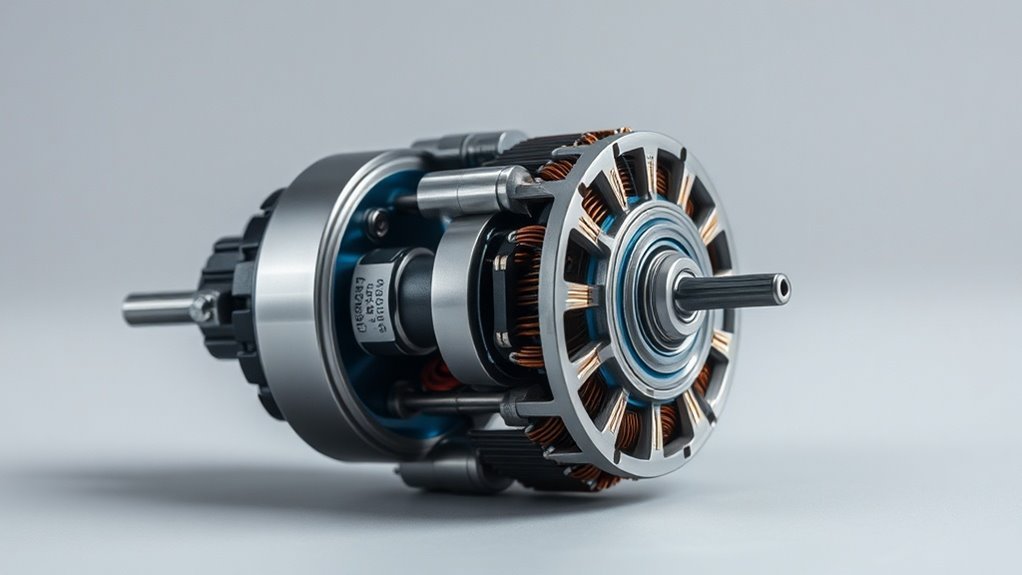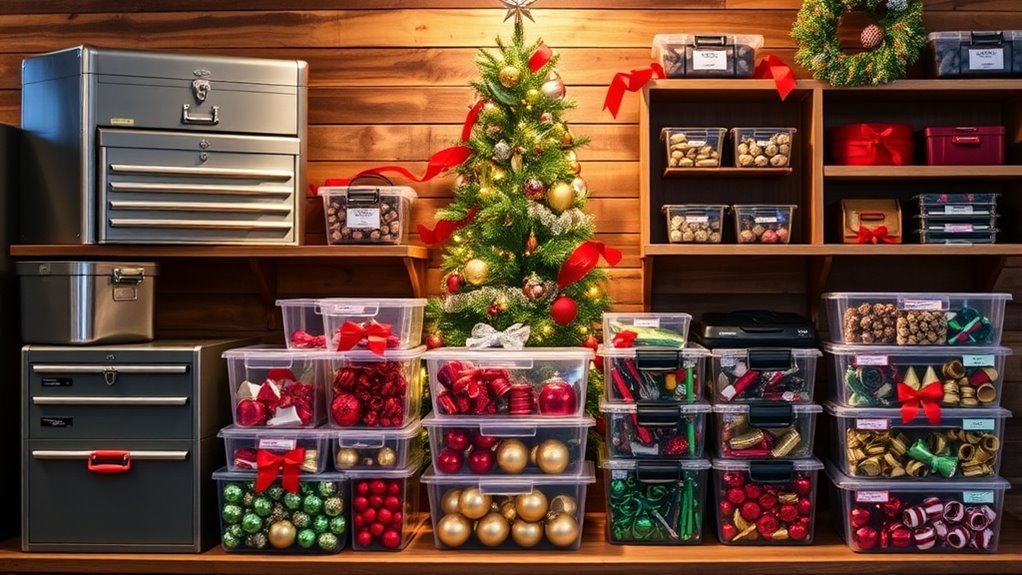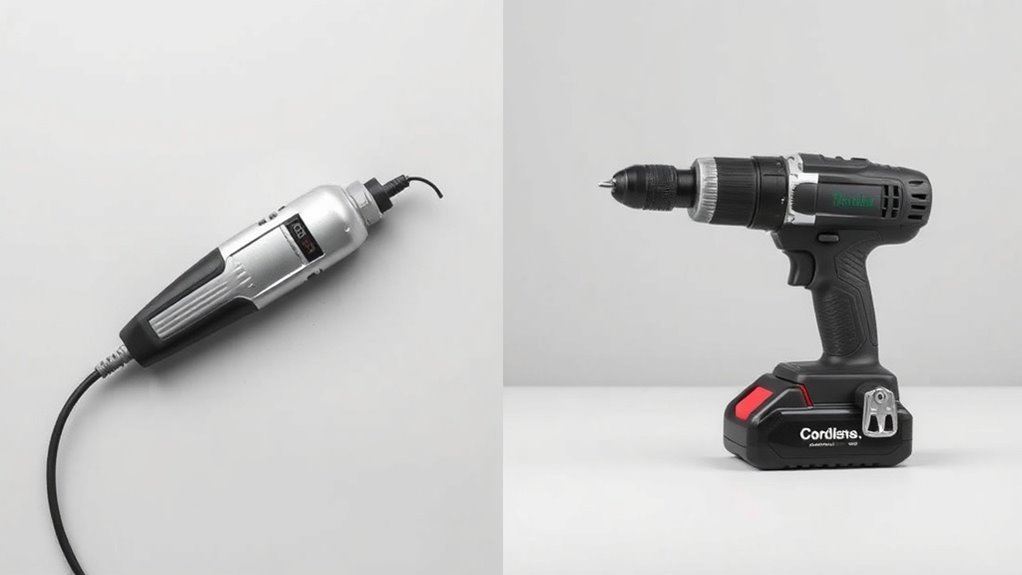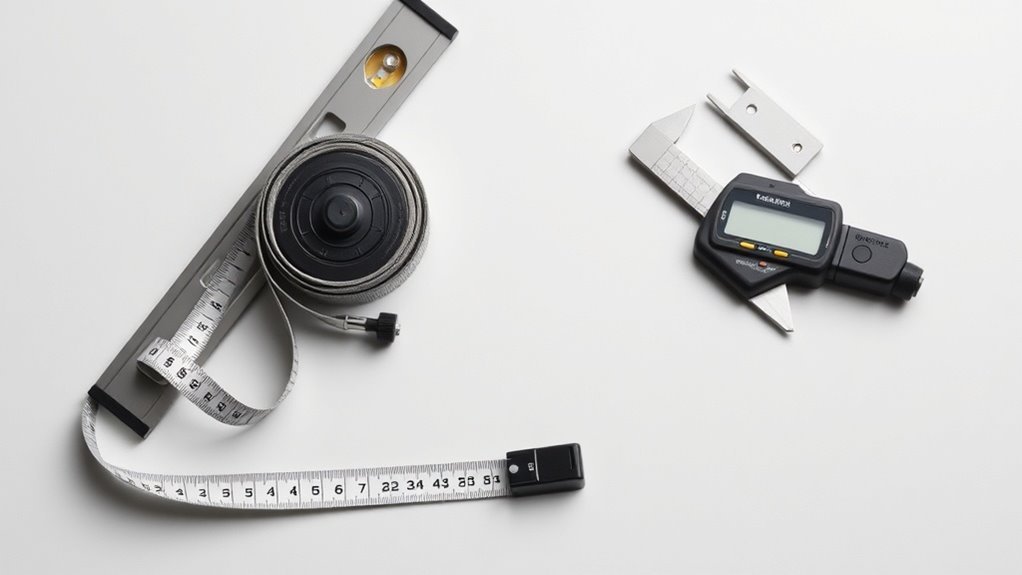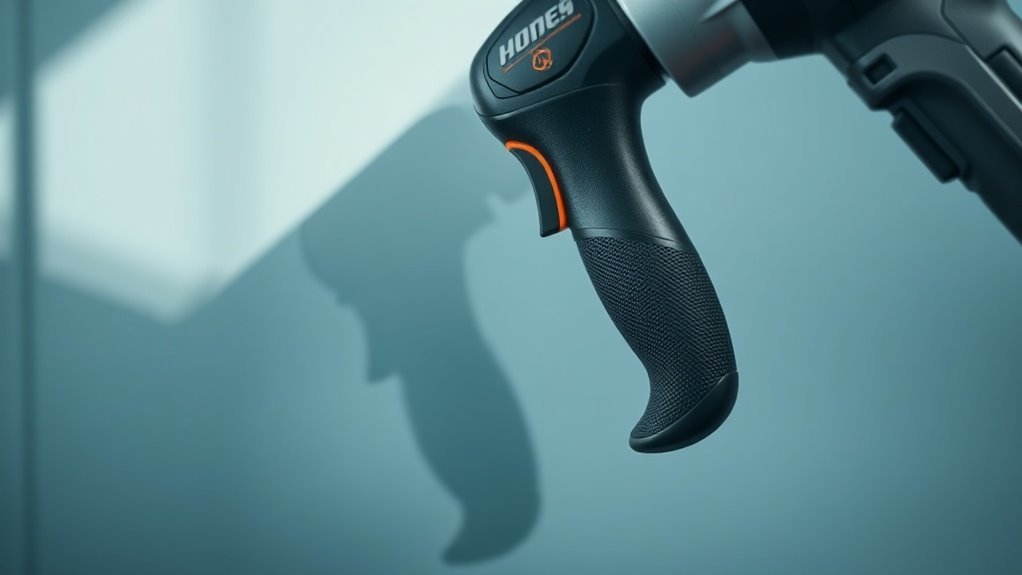Power Tool Storage Tips to Prevent Damage

To prevent damage to your power tools, keep them dry and store them in a cool, well-ventilated area. Use sturdy shelves, organize tools by type or how often you use them, and invest in protective cases. Maintain ideal temperature and humidity levels for best results. Regularly inspect and clean your tools, and store batteries away from sunlight. Label everything for easy access, and you’ll find more tips to extend your tools’ life.
Key Takeaways
- Store tools in a dry, well-ventilated area to prevent rust and damage from moisture.
- Utilize sturdy shelves and organize tools in labeled bins for easy access and protection.
- Keep tools away from direct sunlight to prevent material weakening and deterioration.
- Regularly inspect tools for rust and clean them after use to maintain optimal performance.
- Remove batteries from tools and store them in a cool, dry place to avoid corrosion and damage.
Keep Your Tools Dry
When it comes to protecting your power tools, keeping them dry is essential—especially if you want to avoid rust and corrosion. Moisture can wreak havoc on your equipment, leading to costly repairs or replacements.
To protect your power tools, prioritize keeping them dry to prevent rust and costly damage.
Make sure you store your tools in a dry, well-ventilated area, away from dampness. If you’re working outside, try to clean and dry your tools after each use to prevent moisture buildup.
If you’re in a particularly humid climate, consider using silica gel packets or dehumidifiers in your storage space to absorb excess moisture. Understanding local climate conditions can also help you make better storage decisions tailored to your environment.
Regularly check your tools for any signs of rust, and act quickly if you spot any. Taking these steps will help keep your tools in peak condition for years to come.
Use Proper Shelving and Storage Solutions
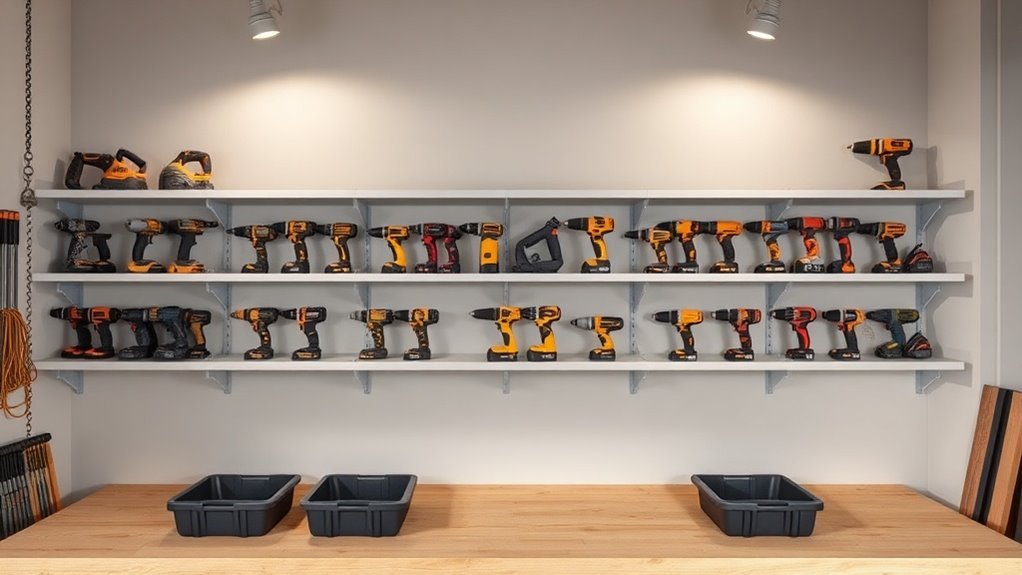
When it comes to power tool storage, having sturdy shelves and designated bins makes all the difference. You need reliable shelving to support the weight of your tools and keep them organized. Plus, using bins can help you avoid clutter and guarantee everything’s easy to find. Additionally, using proper storage containers can further protect your tools and enhance safety in your workspace.
Sturdy Shelf Construction
Constructing a sturdy shelf is essential for effective power tool storage. You want your shelves to support the weight of your tools and withstand everyday use. Choose high-quality materials like plywood or solid wood for durability. Make sure your shelf brackets are properly installed and can handle the load you’re placing on them.
Here’s a quick reference table for shelf materials and their weight capacities:
| Material | Weight Capacity | Recommended Use |
|---|---|---|
| Plywood | Up to 100 lbs | General tool storage |
| Solid Wood | Up to 200 lbs | Heavy-duty tools |
| Metal Shelving | Up to 300 lbs | Workshop and garage use |
Taking the time to build sturdy shelves will keep your power tools safe and organized.
Designated Tool Bins
To keep your power tools organized and easily accessible, designating specific bins for each type of tool is essential.
Start by evaluating your collection, so you know what bins you need. Use stackable bins or drawer organizers to optimize space and make it easy to see each tool.
Label each bin clearly, and group tools by type or frequency of use—this way, you’ll grab what you need quickly without searching through everything.
Make sure your bins are durable; plastic or metal options tend to withstand wear and tear better.
Finally, if you’re short on space, consider mounting bins on walls or inside cabinets.
With designated tool bins, you’ll protect your tools and enhance your workflow dramatically.
Organize by Tool Type or Frequency of Use
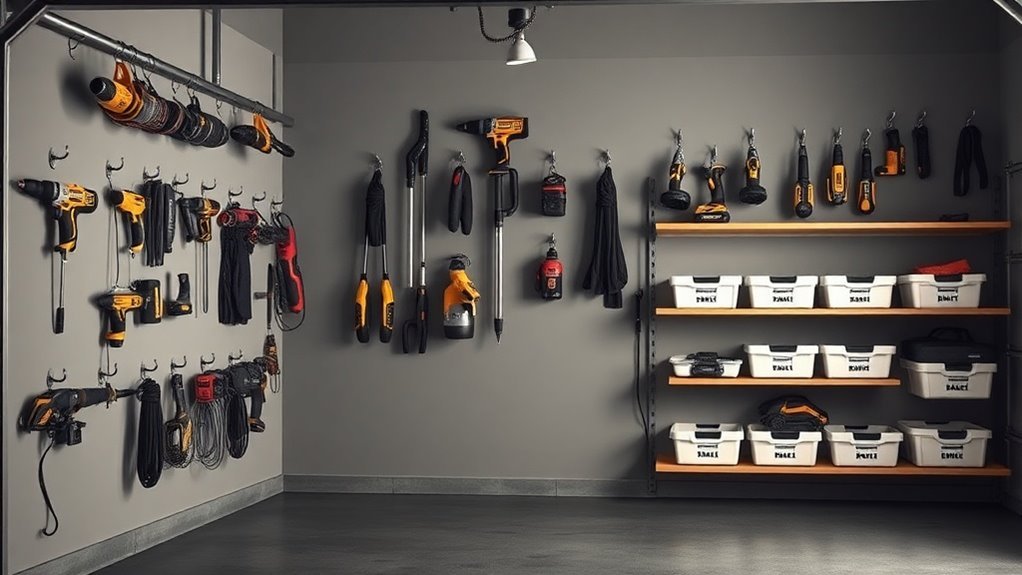
When organizing your power tools, consider grouping similar types together for easy access. It’s also smart to prioritize the tools you use most often, keeping them within reach. Designating unique storage areas for each category can really streamline your workflow. Additionally, incorporating modular storage systems can enhance organization by allowing for flexible configurations tailored to your specific needs.
Group Similar Tools Together
Grouping similar tools together can streamline your workflow and make your workspace more efficient. When you organize your tools by type, like drills, saws, and sanders, it’s easier to find what you need quickly without rummaging through a chaotic collection. This not only saves time but also helps prevent accidental damage to your tools.
Additionally, if you group tools by frequency of use, you’re keeping your most utilized items within reach while storing less frequently used tools further away. Consider using labeled bins or shelves to maintain this organization.
With everything in its place, you’ll enjoy a more productive and safe working environment, letting you focus on your projects without the hassle of disorganization.
Prioritize Daily Use Items
While organizing your tool storage, it’s crucial to prioritize the items you use daily. Start by identifying the tools that you reach for frequently, like your drill, saw, or impact driver. Once you’ve pinpointed these, create a designated space that’s easily accessible. This way, you won’t waste time searching for them when you need to tackle a project.
Consider grouping tools by type or how often you use them, keeping the essentials within arm’s reach. Use transparent containers or labeled bins to quickly identify contents, reducing the chances of damage from mishandling.
Keeping daily use items organized not only streamlines your workflow but also guarantees you’ll maintain your tools in excellent condition for long-term performance.
Designate Unique Storage Areas
After prioritizing your daily-use items, it’s time to create unique storage areas for your tools.
Organizing by tool type or frequency of use will enhance your workflow. Group similar tools together—power drills, saws, or hand tools—so you can easily grab what you need when you need it.
Consider using labeled bins or pegboards to maximize accessibility.
If you rarely use certain items, store them in a less accessible area but still within reach.
This way, your frequently used tools are readily available, while those that are seldom used don’t clutter your workspace.
Invest in Protective Cases and Covers
To guarantee your power tools stay in top condition, investing in protective cases and covers is essential. These tools are valuable, and proper storage assures their longevity. A good case shields them from dust, moisture, and accidental damage.
When selecting covers, make certain they fit snugly and provide adequate padding. Think about portability, too; cases with handles or wheels make transportation easier while keeping your tools safe.
Additionally, cases can help you stay organized. With compartments for individual tools or accessories, you’ll find everything you need without hassle.
Maintain Optimal Temperature and Humidity Levels
Maintaining ideal temperature and humidity levels is crucial for the longevity of your power tools, especially if you’re storing them in a garage or workshop.
Extreme temperatures can cause plastic components to warp, and high humidity levels may lead to rust and corrosion. Aim to keep your storage area between 50°F to 80°F, and relative humidity around 30% to 50%. You can use a dehumidifier or a small heater to help regulate these conditions.
Additionally, placing silica gel packets in your storage area can absorb excess moisture. Make certain your tools are stored away from direct sunlight, as UV rays can weaken materials over time.
Keeping your storage environment stable will protect your investment and enhance your tools’ performance.
Regularly Inspect and Clean Your Tools
While it’s easy to overlook, regularly inspecting and cleaning your power tools is essential for keeping them in top working condition. Dirt, dust, and grime can build up, affecting performance and longevity. Make it a habit to check for any damage or wear, such as frayed cords or rust.
If you notice anything amiss, address it immediately to prevent further issues.
Cleaning your tools after each use can also save you headaches down the road. A simple wipe with a cloth can remove debris, and using compressed air can clear out tight spaces. Remember to check for rust and take necessary precautions during cleaning.
Don’t forget to check the moving parts and lubricate them if necessary. Keeping your tools clean and well-maintained guarantees they’ll be ready whenever you need them.
Store Batteries Safely and Correctly
Since power tool batteries can be a costly investment, storing them safely and correctly is crucial for maximizing their lifespan.
First, always keep batteries in a cool, dry place away from direct sunlight and humidity. Extreme temperatures can damage the internal components, so aim for a consistent environment.
When storing, remove batteries from the tools, and verify the contacts are clean to prevent corrosion. It’s a good idea to keep batteries in their original packaging or a dedicated battery storage case to minimize movement and exposure to dirt.
Ultimately, check the charge level periodically and recharge them as necessary to avoid deep discharging, which can harm battery health.
Taking these precautions helps you get the most out of your power tool batteries.
Label Everything for Easy Access
To guarantee you can quickly find your tools and accessories when you need them, labeling everything is essential. Start by using clear, visible labels for each storage bin and drawer. You can use a label maker or simply write with a permanent marker.
It’s a good idea to categorize tools by type or size, making your search more efficient. For smaller accessories, like screws and bits, consider using small containers with labels indicating their contents.
This approach saves you time and frustration, especially when you’re in the middle of a project. Plus, it helps prevent misplacing items. By taking the time to label, you’ll create a more organized and user-friendly workspace that enhances productivity.
Questions
How Can I Prevent Rust on My Power Tools?
To prevent rust on your power tools, keep ’em clean and dry. Use a rust inhibitor spray, store ’em in a moisture-free environment, and consider silica gel packs to absorb any excess humidity.
Is It Okay to Store Tools in a Damp Garage?
Storing tools in a damp garage isn’t a good idea; imagine biting into a spoiled fruit—everything’s ruined. Moisture breeds rust and deterioration, so consider dry, climate-controlled spaces for your valuable tools instead.
What Types of Shelving Work Best for Heavy Tools?
For heavy tools, sturdy metal or industrial-grade shelving works best. They can handle significant weight without bowing or collapsing. Adjustable shelving helps maximize space, while ensuring your tools remain easily accessible and well-organized.
Can I Store Power Tools in Their Original Boxes?
Storing power tools in their original boxes is like wrapping them in a protective blanket—they fit snugly and shield against dust. Just guarantee proper ventilation to prevent moisture buildup that could harm your tools over time.
How Often Should I Reorganize My Tool Storage?
You should reorganize your tool storage every few months or whenever you notice it’s becoming cluttered. Keeping things tidy helps you find what you need quickly and guarantees your tools remain in good condition.
Conclusion
By keeping your tools dry, using proper shelving, and organizing by type or frequency, you’re protecting your investment. Investing in protective cases, maintaining ideal conditions, and regularly inspecting guarantees longevity. Storing batteries safely and labeling everything for easy access simplifies your workspace. Together, these strategies not only prevent damage but also enhance efficiency. So, take these tips to heart, and watch your tools last longer and perform better, making every project a success.

